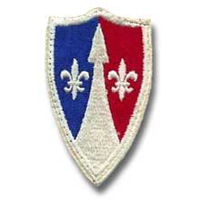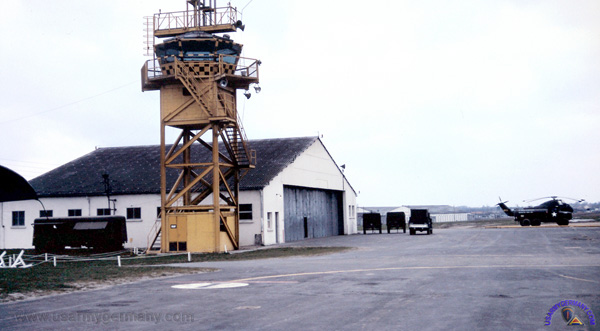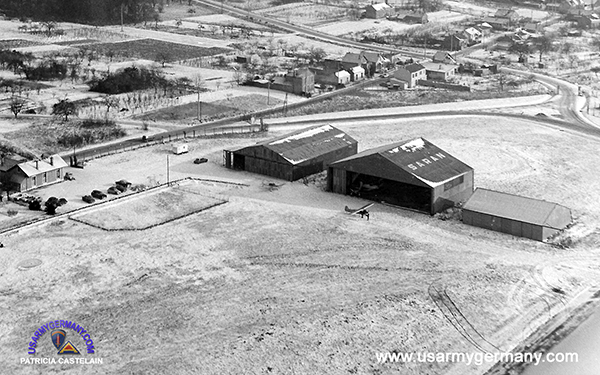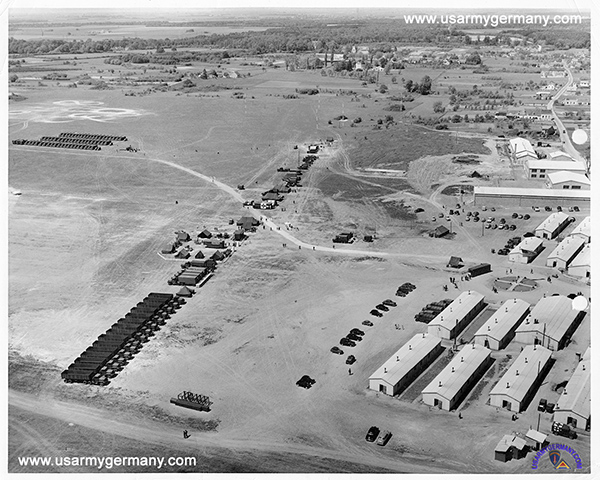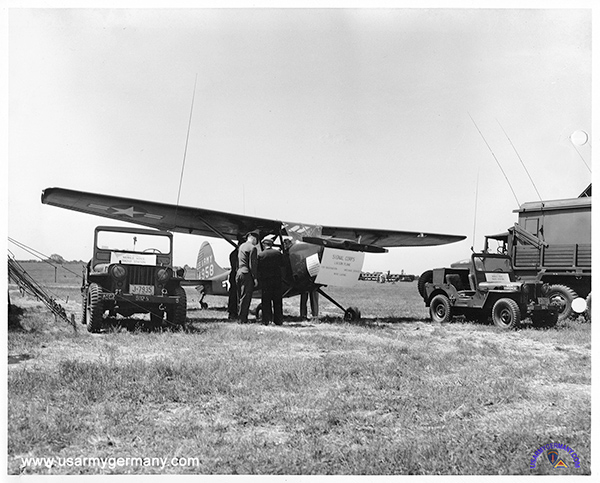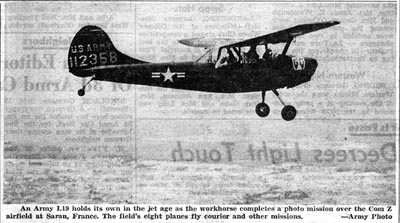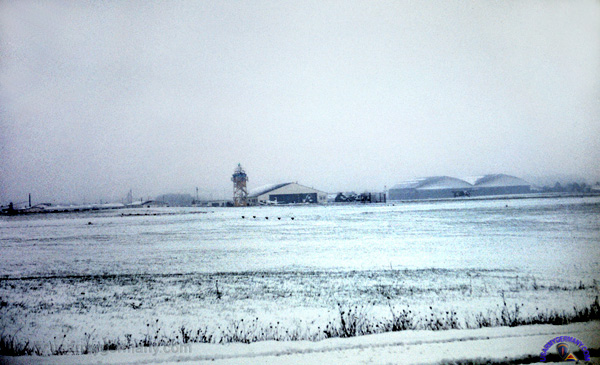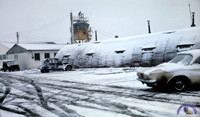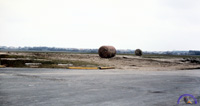| If you do
NOT see the Table of Contents frame to the left of this page, then
Click here to open 'USArmyGermany' frameset |
|||||||||
Saran Army Airfield |
|||||||||
|
|
|||||||||
|
|||||||||
|
|
|||||||||
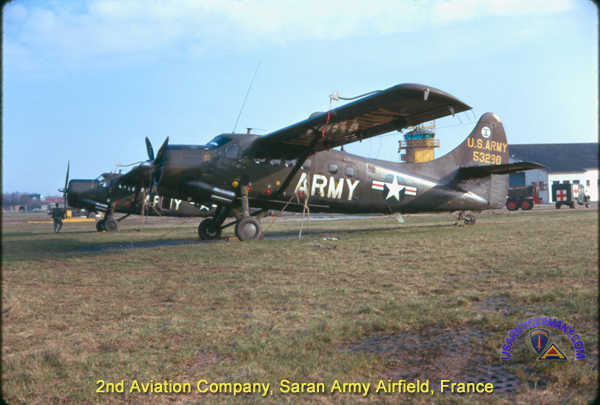 Two U-1 OTTER's of 2nd Avn Co at Saran AAF, 1967 (R.C. Neeb, Jr.) |
|||||||||
| (Source: Email from Patricia Castelain) | |||||||||
| (I was going through some old photos from my grandfatherand found this aerial photo with SARAN written on one of the hangars. Quick Google Search found your site. Not confident that he was with any unit at the time. He flew with the French AF from approximately 1930 through WWII. During WWII he was sent to England to be an Instructor Pilot. Then Canada to do more of the same. The photo has 1966 on the back? Seems the photo was taken before that based on the "look" of the airfield. Just my gut feeling it may not be 1966. After the War, my family moved to Morocco and my grandfather left the AF and did other work, but he kept flying as a hobby. As he passed long ago, no way to ask him. I think it is highly unlikely he was stationed there in any capacity in 1966. I've seen other photos he took in the 60's and he graduated to color film so another issue that makes me think the date (or whatever the number represents?) is wrong. Respectfully suggest you post it with the query on the real date and see if some of your members can add some clarification based on what buildings are present, what is missing maybe? For example "Hangar X was built in 1955 and it is not there yet!" So that might help pinpoint the date. I joined the USAF in 1987 and only after I joined were many of these stories forthcoming!? One Uncle (not blood) but married to my Mom's sister, I'm visiting there, see a photo of him in a USAF Class A uniform on mantle in frame (he's French, my parents immigrants) and I say "Hey that's a US Class A!?" he's like "oh yeah, during the war I was sent to Mississippi to be a P-51 Instructor" Like that's something everyone knows? I guess after the Germans invaded France, the French AF pilots were not allowed to overfly France as the Germans would have too much leverage over them with Family to use as forcing tool to get intelligence. Hence being pushed to England, US, Canada to be instructors. Long winded; so grandfather's name was Henri P. Castelain if you want to give credit for photo but again highly doubtful he was stationed there in any capacity after the war. If I'm wrong and someone comes forward thinking they know him (doubtful as they woudl be very old) he was 6'6" tall!! Insane for a frenchman of that era and not the prototype for a fighter pilot getting into a cockpit. But it was a pretty distinctive feature for a French pilot. |
|||||||||
| 1959 | |||||||||
| (Source: Email from Mike Comito) | |||||||||
| If my memory is as good as it never was, these buildings marked as #4 -- 1959-1960 time frame -- were company headquarters, the weather station (USAF) and enlisted barracks. | |||||||||
| 1965 | |||||||||
| (Source: Email from Steve Buck) | |||||||||
| Steve Buck, Spec5, 1965-67; 2nd Aviation Company, Otter "290" I was assigned to 2nd Aviation Company in Orleans at Saran Field. We had 3 Otters and about 6 pilots. I was crew chief on 553290 Otter until DeGaulle asked us to leave France. I was then sent to Coleman Barracks (Sandhofen, Germany) for a short time. Then we were sent to England to setup a new post at Burtonwood Air Base. Really enjoyed being a crew chief and flying all over Europe: Belgium, France, Germany, Holland, England. While in Orleans I had a monthly flight to Naples, Italy. Most of my flights were in "290" and some in "300." Some of the places we visited were Venice, Verona, Genoa, Vicenza, Pisa. At Coleman I was with 56th Avn Co. I was sSent to Burtonwood with 1 Otter and 1 helicopter, CH34, with another crew chief to support a general. We also had some Airforce personnel stationed there for radar , weather, etc. At Burtonwood we had one club which everyone could use, Officers included. There was no rank when you were there. My last flight on 290 was back to Germany for my trip home. |
|||||||||
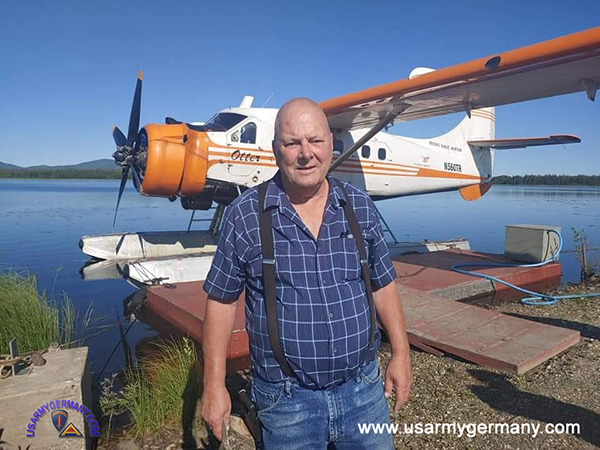 Steve Buck reunited with his old U-1 OTTER in Alaska |
|||||||||
 Steve Buck and his oldest son during their trip to Alaska to visit "290" |
|||||||||
| Last summer we found "290" in Alaska as a bush plane in Bettles, AK. I contacted the owner who invited me up for a visit. I took my oldest son and family along. They put us up in cabins and gave us a free flight up into the artic circle. I got to fly in copilot's seat which I used to fly in quite often as crew chief. They then treated us to a moose barbecue before we left. That was probably my last flight on 290. It was a great trip. Regarding the above aerial photo of Saran Army Airfield, 1964: #1 56th Avn Co hangar; 2nd Avn had a little room in there for coffee and to get out of weather. We had 3 Otters and 2 crew chiefs. Did all our work outside on the flight line. #3 Flight operations for 2nd Avn and 56th Avn #4 I believe that was where radar techs were located #5 was were we had tiedowns for the Otters. |
|||||||||
| History | |||||||||
| 1953 | |||||||||
| (Source: STARS & STRIPES, February 8, 1953) | |||||||||
| All units stationed at Saran have been attached to the 9th Trans Highway Transport Gp and placed under the command of Lt Col Eugene M. Elliott, Jr. The establishment of all units under one command is designed to eliminate duplication and conserve manpower and equipment. |
|||||||||
| (Source: STARS & STRIPES, May 7, 1953) | |||||||||
| Col Chester M. Willinham, Orleans Area Command (OAC) CO has announced that the OAC will observe Armed Forces Day on May 16 with a parade and open house at the Saran Army Airfield. Maj Gen Lemuel Mathewson, Com Z CG, has been invited to the review, along with local French officials. |
|||||||||
| 1954 | |||||||||
| (Source: STARS & STRIPES, November 7, 1954) | |||||||||
| The tents housing many of the units located to Saran Army Airfield are being replaced by "hutments." The hutments are completely wood-framed, covered with siding, then overlayed with wind-and-rain-resistant tarpaper, nailed and lathed down and tar-sealed. A total of 39 hutments will be built to replace the outworn and outmoded tents. Units that will eventually occupy the new hutmemnts are: |
|||||||||
| 1956 | |||||||||
(Source: STARS & STRIPES, Sept 14, 1956) |
|||||||||
'Smallest-Largest Airline in the World' Saran's Postage-Stamp Field Serves All of France ORLEANS, France, Sept. 13 (Special) -- The Army's airstrip at Saran, France, a few miles from Com Z Hq here, has been called the "smallest-largest airline in the world." For though it services all of France and is operational 24 hours a day, its 2,000-foot runway has a mere postage-stamp appearance. Saran's chief function is to provide fast transportation for the commanding general and his staff to any point in Com Z and beyond. The flight section also has a 600-mile daily run covering all major installations in the sub-commands and has special missions to such distant places as Hamburg, Germany, and Milan, Italy. The strip has been a lifesaver in emergencies. Serum, vaccine and other medical supplies are quickly flown where needed. There was an emergency of a different sort recently when Col Miller T. Nesbitt, flight section chief, flew a new- born baby from Base Section to Stuttgart, Germany. The operation of the airstrip constitutes a fulltime job for the handful of officers and enlisted men at Saran. A brand-new weather station operated by an Air Force lieutenant and Army enlisted personnel makes flying possible at any time and in any weather. Each of the officers in the flight section, besides being a rated pilot, is concerned with some aspect of the field's operation or administration. Since aviation is not a branch of service, each must maintain his proficiency in his own branch. |
|||||||||
|
|||||||||
| Today the field's eight planes are performing the large mission of making every point in Corn Z, from Periguex in the south to Metz in the East, only a matter of hours, or minutes, away. | |||||||||
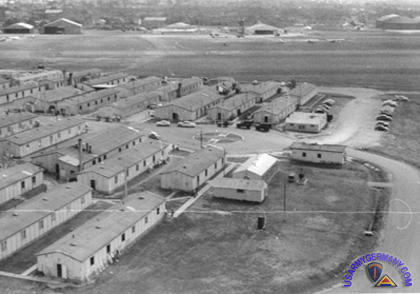 Saran Army Airfield (background), 1960s (Timothy F. Casey) |
|||||||||
|
|||||||||
| Flight Section, Communications Zone | |||||||||
| 1954 | |||||||||
| (Source: STARS & STRIPES, July 27, 1954) | |||||||||
| Air transportation is Com Z's answer to the long distances between the command's scattered installations located on the 600-mile line of communications in France and Germany. Com Z's Flight Section is located at Saran AAF (near Orleans, France) and plays a vital role in supporting the Com Z commanding general and his staff . The Flight Section, currently under the command of Lt Col Elmer P. Fleming, Jr. was formed in 1951. Also in that year, air sections were formed at Com Z's major subordinate commands, Advance Section at Verdun (Verdun AAF) and Base Section at La Rochelle (Laleu AAF). As other subordinate installations were craeted, arrangements were made to use nearby civilian airports to serve those installations. (Three airfields were constructed at or near more remote depots.) The most important Army airfield in France is Saran. The field has night lighting equipment, radio aids and other provisions making it the first all-weather AAF in France (1). Com Z's flight section flies daily courier missions from Saran (Orleans) to Verdun and La Rochelle, carrying priority official mail and documents. There are also frequent flights to HQ USAREUR at Heidelberg. In addition, the air section carries limited amount of cargo (primarily spare parts, medical equipment and priotiyt items) and transports personnel (it averages 400 passengers a month). New pilots arriving in command go through instrument training at Chateauroux Air Base (Central Air Material Area) first. The flight section's planes are serviced and repaired at the aircraft service center at Metz, France (Frescaty Arfield). (The shops at Metz provide maintenance and supply and are capable of rebuilding aircraft. A contract with a civilian company provides for major repair and inspection services. The Metz center also supports the two aviation maintenance companies -- 35th AAM Co, Illesheim and 93rd AAM Co, Stuttgart-Echterdingen -- assigned to 7th Army.) |
|||||||||
| (1) The airfield at Saran underwent a major improvement effort in 1953-54 (cost: $125,000). The renovation efforts included lengthening the runway (2,100 feet). | |||||||||
| Related Links: |
|||||||||
